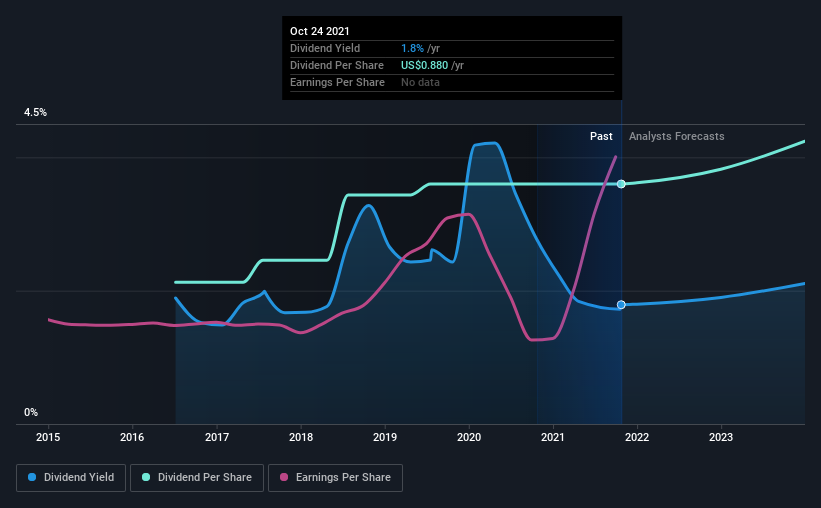Synchrony Financial (NYSE:SYF) Looks Interesting, And It's About To Pay A Dividend
It looks like Synchrony Financial (NYSE:SYF) is about to go ex-dividend in the next three days. The ex-dividend date is one business day before a company's record date, which is the date on which the company determines which shareholders are entitled to receive a dividend. The ex-dividend date is of consequence because whenever a stock is bought or sold, the trade takes at least two business day to settle. Meaning, you will need to purchase Synchrony Financial's shares before the 29th of October to receive the dividend, which will be paid on the 12th of November.
The company's next dividend payment will be US$0.22 per share, on the back of last year when the company paid a total of US$0.88 to shareholders. Based on the last year's worth of payments, Synchrony Financial stock has a trailing yield of around 1.8% on the current share price of $49.19. If you buy this business for its dividend, you should have an idea of whether Synchrony Financial's dividend is reliable and sustainable. As a result, readers should always check whether Synchrony Financial has been able to grow its dividends, or if the dividend might be cut.
View our latest analysis for Synchrony Financial
If a company pays out more in dividends than it earned, then the dividend might become unsustainable - hardly an ideal situation. Synchrony Financial has a low and conservative payout ratio of just 12% of its income after tax.
Companies that pay out less in dividends than they earn in profits generally have more sustainable dividends. The lower the payout ratio, the more wiggle room the business has before it could be forced to cut the dividend.
Click here to see the company's payout ratio, plus analyst estimates of its future dividends.
Have Earnings And Dividends Been Growing?
Stocks in companies that generate sustainable earnings growth often make the best dividend prospects, as it is easier to lift the dividend when earnings are rising. If earnings fall far enough, the company could be forced to cut its dividend. It's encouraging to see Synchrony Financial has grown its earnings rapidly, up 23% a year for the past five years.
Many investors will assess a company's dividend performance by evaluating how much the dividend payments have changed over time. Since the start of our data, five years ago, Synchrony Financial has lifted its dividend by approximately 11% a year on average. Both per-share earnings and dividends have both been growing rapidly in recent times, which is great to see.
Final Takeaway
From a dividend perspective, should investors buy or avoid Synchrony Financial? Companies like Synchrony Financial that are growing rapidly and paying out a low fraction of earnings, are usually reinvesting heavily in their business. This strategy can add significant value to shareholders over the long term - as long as it's done without issuing too many new shares. We think this is a pretty attractive combination, and would be interested in investigating Synchrony Financial more closely.
In light of that, while Synchrony Financial has an appealing dividend, it's worth knowing the risks involved with this stock. For example, Synchrony Financial has 2 warning signs (and 1 which is a bit unpleasant) we think you should know about.
We wouldn't recommend just buying the first dividend stock you see, though. Here's a list of interesting dividend stocks with a greater than 2% yield and an upcoming dividend.
This article by Simply Wall St is general in nature. We provide commentary based on historical data and analyst forecasts only using an unbiased methodology and our articles are not intended to be financial advice. It does not constitute a recommendation to buy or sell any stock, and does not take account of your objectives, or your financial situation. We aim to bring you long-term focused analysis driven by fundamental data. Note that our analysis may not factor in the latest price-sensitive company announcements or qualitative material. Simply Wall St has no position in any stocks mentioned.
Have feedback on this article? Concerned about the content? Get in touch with us directly. Alternatively, email editorial-team (at) simplywallst.com.

 Yahoo Finance
Yahoo Finance 
